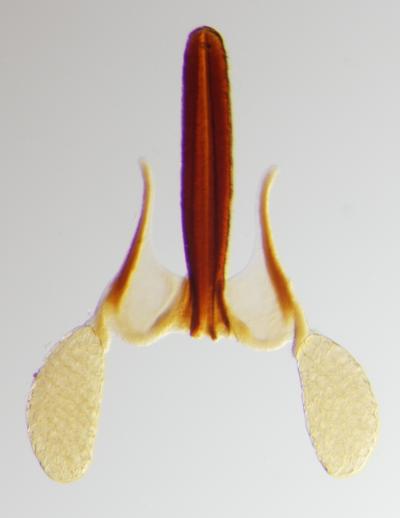First evidence of plants evolving weaponry to compete in the struggle for selection

This is an example of the horned pollinaria found in South American milkweed. Credit: Andrea Cocucci
The team, led by Dr. Andrea Cocucci from the Instituto Multidisciplinario de Biologia Vegetal of Argentina, studied a species of milkweed (Apocynaceae), found in tropical climates.
While plants do not mate like animals, but rather reproduce via pollinators such as insects or birds, competition between individuals to exploit those pollinators can result in confrontation between the plants.
Milkweed reproduce by hooking sacs of pollen grains, known as pollinia, to the bodies of birds and other pollinators, which can be unwittingly dropped into another flower to complete pollination.
It is possible for multiple pollinarium to become entangled together due to the limited number of attachment points on the pollinator, and this Dr. Cocucci's team believe, is the source of confrontation.
The team studied the South America milkweed genus Oxypetalum and found horn-like structures on the pollinia sacs which have no obvious biological use. The paper suggests that these horns are used to prevent the sacs from being hooked together with pollinia from other parent plants.
“Our results suggest that neither self-propulsion nor well-developed sensory perception are required for sexual selection to take place through intrasexual struggles,” said Dr. Cocucci.
“Apparently, only physical contact is enough to influence the mating success of competitors and to promote the evolution of defensive and attack weaponry.”
Media Contact
More Information:
http://www.wiley.comAll latest news from the category: Life Sciences and Chemistry
Articles and reports from the Life Sciences and chemistry area deal with applied and basic research into modern biology, chemistry and human medicine.
Valuable information can be found on a range of life sciences fields including bacteriology, biochemistry, bionics, bioinformatics, biophysics, biotechnology, genetics, geobotany, human biology, marine biology, microbiology, molecular biology, cellular biology, zoology, bioinorganic chemistry, microchemistry and environmental chemistry.
Newest articles

Combatting disruptive ‘noise’ in quantum communication
In a significant milestone for quantum communication technology, an experiment has demonstrated how networks can be leveraged to combat disruptive ‘noise’ in quantum communications. The international effort led by researchers…

Stretchable quantum dot display
Intrinsically stretchable quantum dot-based light-emitting diodes achieved record-breaking performance. A team of South Korean scientists led by Professor KIM Dae-Hyeong of the Center for Nanoparticle Research within the Institute for…

Internet can achieve quantum speed with light saved as sound
Researchers at the University of Copenhagen’s Niels Bohr Institute have developed a new way to create quantum memory: A small drum can store data sent with light in its sonic…





















